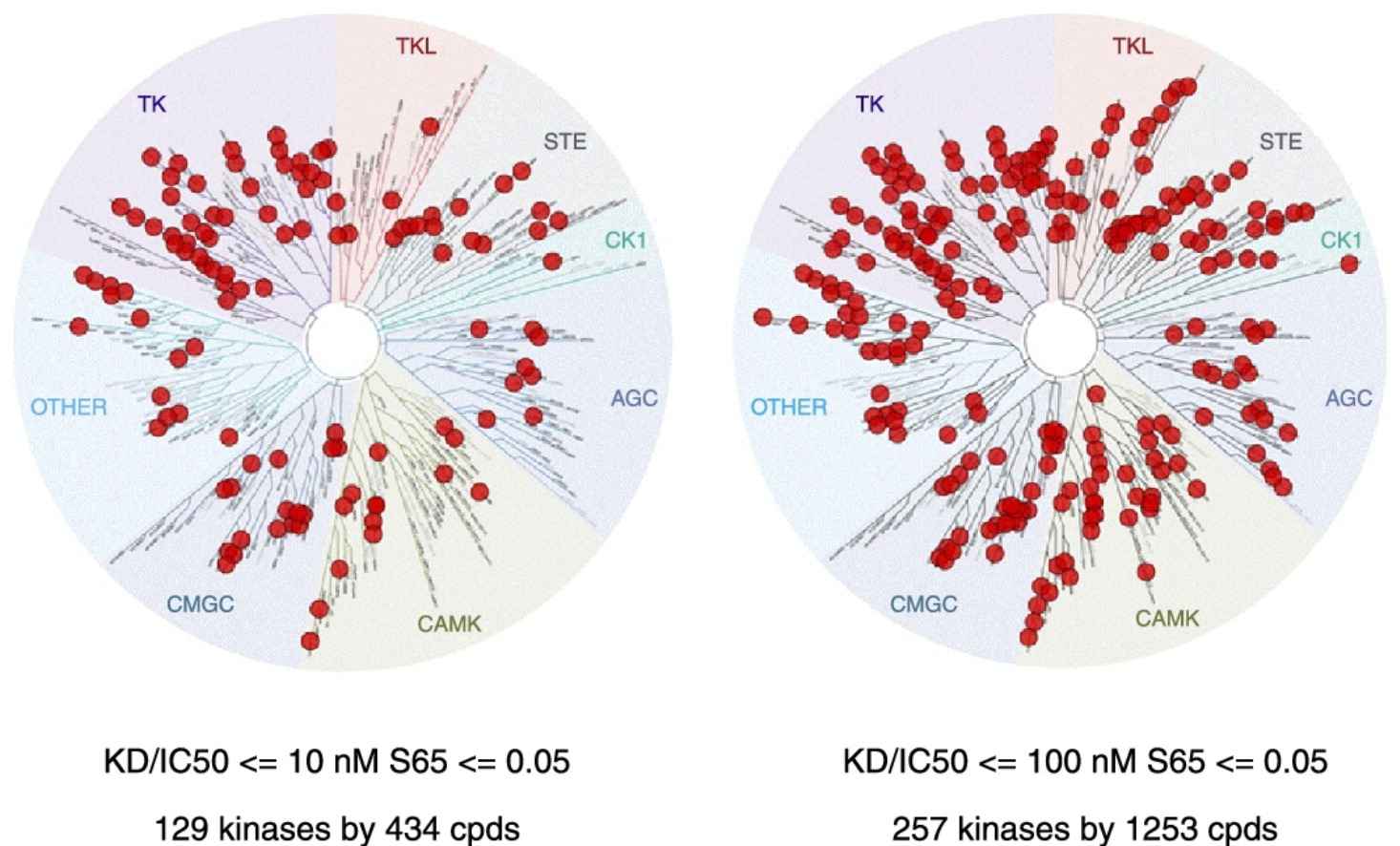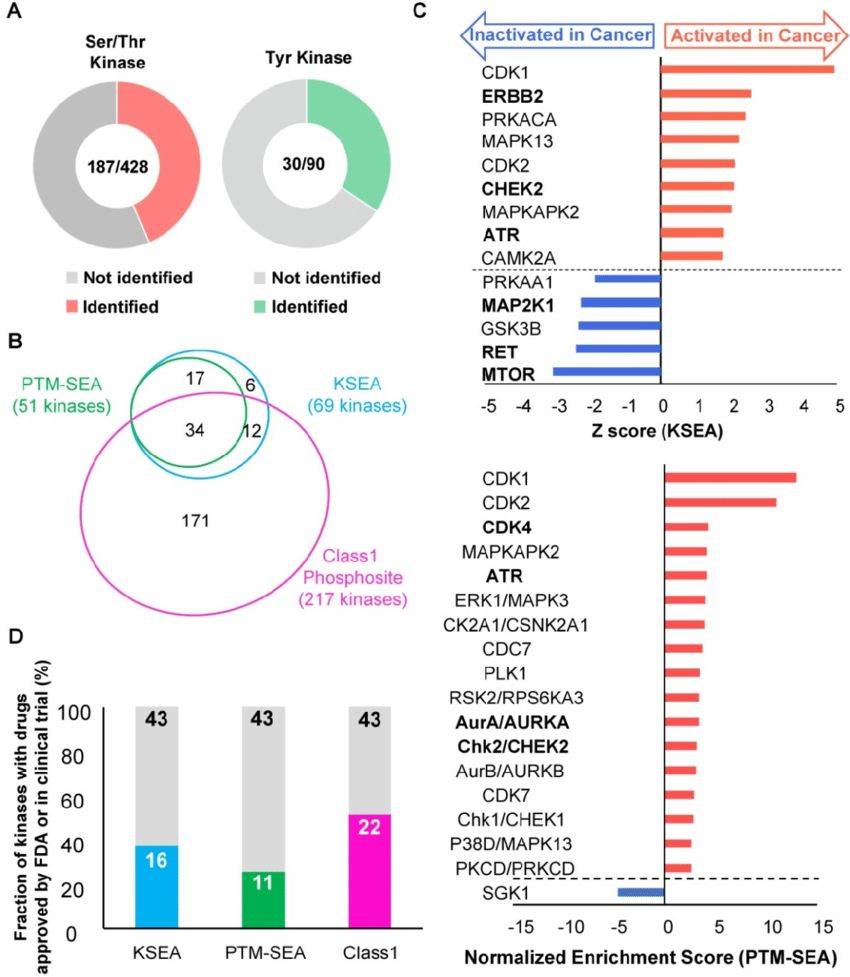Quantitative Kinome Profiling is an advanced, state-of-the-art approach used to monitor the activity of kinases, a type of protein that plays a pivotal role in cell signaling pathways. Kinases are integral to the functioning of cells, and their dysregulation is often at the heart of diseases such as cancer. This makes them an essential area of study for potential therapeutic interventions, and our Quantitative Kinome Profiling Services equip researchers with the necessary tools to conduct this crucial research.
 Grad-CAM results for two top enzyme candidates in reaction rules R1 and R2 (Vikas Upadhyay, et al., 2023)
Grad-CAM results for two top enzyme candidates in reaction rules R1 and R2 (Vikas Upadhyay, et al., 2023)
Service Process
Our Quantitative Kinome Profiling Service is a meticulously developed process that has been designed to ensure the highest quality results possible. With a careful and thoughtful approach, we follow a four-step process to provide our clients with the most accurate and insightful data:
- Sample preparation: The first step in our process involves a meticulous preparation of your samples. We understand that the accuracy of results depends heavily on the integrity of the samples, which is why we take great care in their handling and processing. Every effort is made to ensure that the samples remain in their most authentic state, thereby providing the most reliable basis for subsequent steps.
- Kinase activity measurement: Once the samples have been appropriately prepared, we then proceed to measure the activity of kinases in your samples. Our team is equipped with expertise in a range of specialized techniques, allowing us to select the most suitable method for each individual project. This ensures that we are not just measuring but providing the most accurate and precise measurements possible.
- Data analysis: After the kinase activity has been accurately measured, the data is then passed on to our team of experts for analysis. We employ the use of advanced statistical tools, combined with our years of experience and knowledge in the field, to interpret the data. This step allows us to extract meaningful insights into the activity of kinases, which could provide invaluable information for your research or therapeutic strategies.
- Report generation: The final step in our process is the generation of a comprehensive report. After our thorough analysis, we compile all of the findings into a detailed report that not only presents the results, but also delves into their potential implications. This report is designed to guide future research and strategic planning, offering valuable direction and insight for your future endeavors.
We're here to assist you. If you have any questions, need more information, or would like to discuss a potential project, please don't hesitate to contact us. Our team is always eager to help and share our expertise.
Applications
| Application |
Description |
| Drug Discovery |
Quantitative kinome profiling services play a crucial role in drug discovery by identifying and characterizing kinase targets for the development of novel therapeutics. By comprehensively analyzing the activity of kinases within biological samples, such as cells or tissues, these services enable researchers to pinpoint potential drug targets implicated in various diseases. This information aids in the design and optimization of small molecules or biologics that selectively modulate specific kinases, leading to the development of targeted therapies with improved efficacy and safety profiles. |
| Cancer Research |
Kinase dysregulation is a hallmark of cancer, making quantitative kinome profiling indispensable in cancer research. These services allow for the systematic assessment of kinase activity patterns across different cancer types and stages, providing insights into the underlying signaling pathways driving oncogenesis and tumor progression. By identifying aberrant kinase signaling networks, researchers can uncover potential therapeutic targets for the development of precision cancer treatments. Additionally, kinome profiling facilitates the discovery of kinase biomarkers for cancer diagnosis, prognosis, and monitoring of treatment responses. |
| Biomarker Discovery |
Quantitative kinome profiling services are instrumental in biomarker discovery efforts aimed at identifying molecular signatures associated with disease states or treatment responses. By quantifying the activity levels of numerous kinases simultaneously, these services enable the identification of kinase biomarkers that exhibit differential expression or activation patterns under specific conditions. Such biomarkers hold promise for diagnosing diseases, predicting patient outcomes, and monitoring the efficacy of therapeutic interventions. Kinome-based biomarkers offer valuable insights into disease mechanisms and provide clinicians with valuable tools for personalized patient management. |
| Cell Signaling Studies |
Quantitative kinome profiling services are invaluable for investigating the complex network of intracellular signaling pathways that regulate cellular behavior and function. By quantifying the activity levels of multiple kinases simultaneously, researchers can dissect signaling cascades and elucidate the crosstalk between different pathways. This enables a deeper understanding of how cells respond to various stimuli, including growth factors, hormones, and environmental stressors. Kinome profiling facilitates the identification of key signaling nodes and regulatory mechanisms underlying physiological processes, development, and disease. Moreover, it provides essential insights into the mechanisms of drug action and resistance, aiding the development of more effective therapeutic strategies. |
| Target Validation |
Kinase target validation is a critical step in the drug discovery process, and quantitative kinome profiling services play a pivotal role in this endeavor. By assessing the activity profiles of potential kinase targets in relevant cellular or disease models, researchers can validate their suitability for therapeutic intervention. Kinome profiling enables the identification of kinases that are dysregulated or hyperactivated in disease states, thereby validating them as potential drug targets. Additionally, these services help assess target engagement and selectivity of candidate compounds, providing essential data for advancing drug candidates through preclinical and clinical development stages. |
| Protein Function Studies |
Kinases play pivotal roles in regulating protein function and cellular processes through phosphorylation-mediated signaling events. Quantitative kinome profiling services enable researchers to study the functional impact of kinase activity on protein substrates and cellular pathways. By identifying the substrates phosphorylated by specific kinases under different conditions, these services facilitate the elucidation of signaling networks and downstream effector mechanisms. Protein function studies based on kinome profiling data provide insights into cellular signaling dynamics, protein-protein interactions, and post-translational modifications, contributing to our understanding of molecular mechanisms underlying physiological and pathological processes. |
Case Study
The figure illustrates the profiling of the kinome through the utilization of phosphoproteomic data. A. The number of Ser/Thr kinase (left chart, red) and Tyr kinase (right chart, green) whose class1 phosphosites on the kinases themselves were identified is shown. B. A proportional venn diagram of the three kinomes identified from KSEA (Cyan), PTM-SEA (Green), and class 1 phosphosite on kinase (Magenda) is shown. C. Kinome profiling is shown to compare the phosphoproteomic data of the cancer tissues and normal mucosas. Kinases with a p value < 0.05 based on the KSEA (upper) and the PTM-SEA (lower) algorithm are shown. These kinases are predicted to be activated (red bars) and inactivated (blue bars) in cancer tissue. Kinases whose drugs are approved by FDA-approved or in clinical trials are shown in bold font. D. The percentage of kinases with drugs either approved for use or in clinical trials was represented by cyan (identified by KSEA), green (identified by PTM-SEA), and magenta (identified as class 1 phosphosites on kinases), respectively.
 Phosphoproteomics of cancer and normal tissues collected by endoscopic biopsy (Yuichi Abe, et al., 2020)
Phosphoproteomics of cancer and normal tissues collected by endoscopic biopsy (Yuichi Abe, et al., 2020)
FAQs
Below are some frequently asked questions and answers about our services, providing in-depth information about kinome profiling, its importance, the process, the potential applications, and the support offered by our team. If you have more specific or detailed questions, don't hesitate to get in touch with us directly.
Q: Could you please explain what a kinase is?
A: A kinase is a type of enzyme, specifically a protein, that is responsible for adding a phosphate group to other proteins. This process is referred to as phosphorylation. The addition of a phosphate group can drastically alter the function of the targeted proteins, making this process integral to numerous cellular processes.
Q: Why is it important to conduct kinome profiling?
A: Kinome profiling serves as a powerful tool in the hands of researchers, allowing them to thoroughly understand the activity of kinases within cells. By creating a comprehensive map of kinase activity, we can glean invaluable insights about disease mechanisms and identify potential targets for therapeutic intervention.
Q: Can you explain how kinome profiling is carried out?
A: Kinome profiling is a highly specialized process. It involves using advanced techniques to measure the activity of kinases present in a given sample. This process necessitates expert knowledge in the field and the use of sophisticated equipment, both of which our team is proud to possess.
Q: What types of samples can be used when performing kinome profiling?
A: The process of kinome profiling is highly versatile and can be conducted on a wide array of sample types. These range from cell lines and tissue samples to bodily fluids, among many others.
Q: How long does the process of kinome profiling usually take?
A: The timeframe for kinome profiling can vary significantly, contingent on the complexity of the sample and the specific techniques employed. However, our team is committed to working diligently to deliver results as expeditiously as possible while ensuring the highest quality standards.
Q: Could you elaborate on the type of information kinome profiling can provide?
A: Kinome profiling can yield an abundance of information about the activity of kinases in a particular sample. This information can prove vital in enhancing our understanding of disease processes and identifying potential pathways for treatment.
Q: Is kinome profiling applicable in the realm of drug discovery?
A: Absolutely! Kinome profiling can be leveraged to identify potential therapeutic targets for drug discovery. It can help uncover dysregulated kinases in disease states, which can then be specifically targeted with drugs.
Q: What range of diseases can be studied using kinome profiling?
A: Kinome profiling is an incredibly versatile tool that can be utilized to study a wide range of diseases. These include, but are not limited to, cancer, neurodegenerative diseases such as Alzheimer's and Parkinson's, autoimmune diseases, and more.
Q: What support do you provide to clients during the kinome profiling process?
A: We offer comprehensive support to our clients throughout the kinome profiling process, from initial consultation, through the testing process, to the final delivery of results.
Q: How do you handle sensitive data and ensure its confidentiality?
A: We strictly adhere to all data protection regulations and take all necessary precautions to ensure the confidentiality of your data.

































 Grad-CAM results for two top enzyme candidates in reaction rules R1 and R2 (Vikas Upadhyay, et al., 2023)
Grad-CAM results for two top enzyme candidates in reaction rules R1 and R2 (Vikas Upadhyay, et al., 2023) Phosphoproteomics of cancer and normal tissues collected by endoscopic biopsy (Yuichi Abe, et al., 2020)
Phosphoproteomics of cancer and normal tissues collected by endoscopic biopsy (Yuichi Abe, et al., 2020)